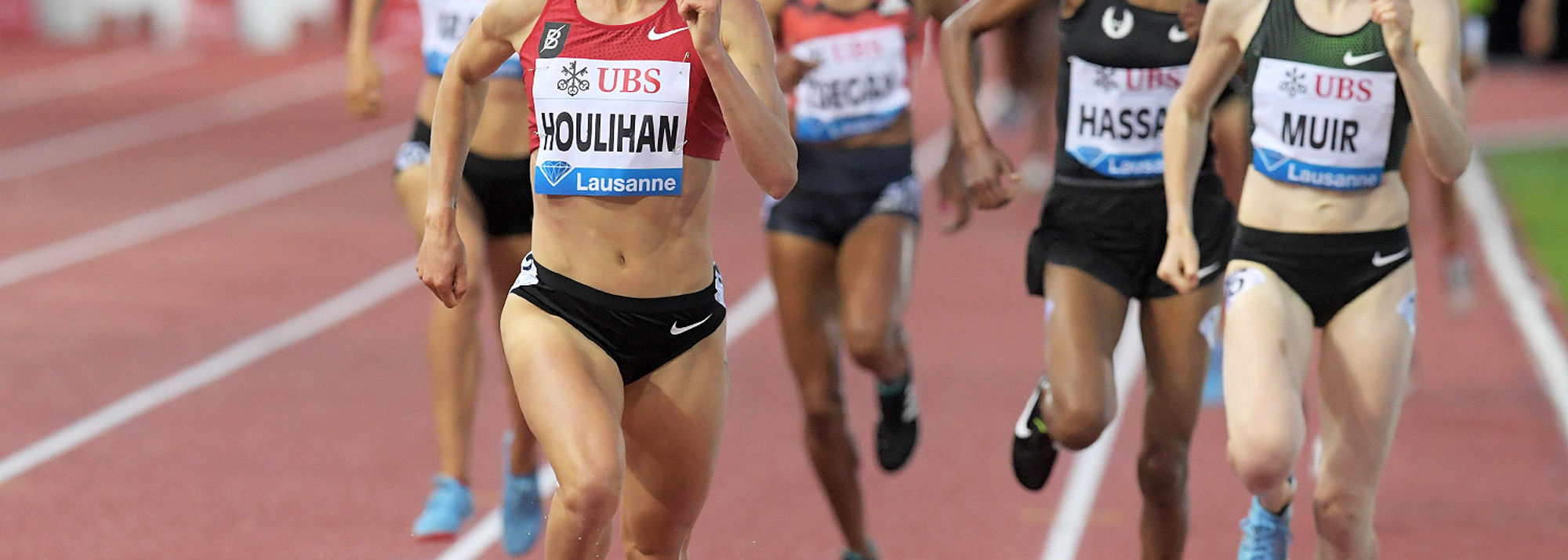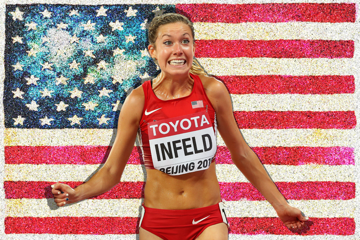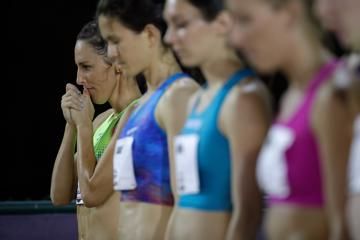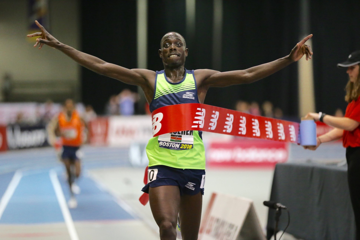Shelby Houlihan wins the 1500m at the IAAF Diamond League meeting in Lausanne (© Gladys Chai von der Laage)
It's the most feared weapon in middle-distance running, and now that Shelby Houlihan has learned how to use it, she's daring to dream of the ultimate prize.
Late in the race, when she is scorching towards the finish, whirring her legs like a propeller, Shelby Houlihan creates an image in her mind.
“When I change to that last gear,” she says, “I actually visualise shifting gears in a car and immediately try to increase my leg turnover. During that last 200m, I focus on increasing speed but still saving one last gear for the last 50 metres.”
In middle-distance running, gold is most often mined by those with the best kick, and in that department the 25-year-old American possesses a gift of enviable quality.
At the US Championships in Des Moines last month, she unfurled a 57.67-second final lap to defeat 2011 world champion Jenny Simpson over 1500m, then returned the following day and smashed a 13-second final 100m to take 5000m gold. More recently, in Lausanne, she powered away from the world’s best 1500m runners to obliterate her PB and win, with plenty of room to spare (see cover photo), in 3:57.34.
Her final 100m, run in 14.34, was more than a second quicker than anyone else in the race.
Houlihan was always fast, but the difference now, the thing that makes her a threat to anyone with the misfortune to see her sitting on their shoulder as they turn for home, is that she is strong.
Building the Engine
“Strength,” she says is the secret to a great kick. “I’ve always had the speed, but I was never aerobically strong enough to use any of that speed at the end of races.”
Over the past several years, Houlihan has crept her mileage up each season, from 30 miles a week in her freshman year of college to her current load of 80 miles a week. She was an Olympic finalist in 2016 and a world finalist last year over 5000m, but those performances were only small steps towards what she is fast becoming: one of the best middle-distance athletes in the world.
In Jerry Schumacher, she has one of the great gurus in world athletics tracing her path to the top.
In the Nike Bowerman Track Club, she has friends, teammates who are every bit as accomplished and driven as her.
Houlihan may be 25, but don’t let her relative youth fool you: she’s been dreaming of this for 20 years.
Future Perfect
At the age of five, at her home in Sioux City, Iowa, Houlihan jotted a picture of herself running in the Olympic Games, coming home first inside a packed stadium. At school, whenever teachers would ask what she wanted to be when she grew up, Houlihan’s answer was unwavering.
“It was always an Olympic runner,” she says. “I’ve always had the feeling that this is what I was meant to do.”
She comes from a family of runners, and in the early years Houlihan would follow her mom, Connie, from the family car and offer her water on her long runs. “I saw the way she loved running,” says Houlihan, “which allowed me to learn how to love running as well.”
At the age of five she was already running one-mile cross country races, though it was only in high school that her talent blossomed, where she racked up state titles and clocked 2:07.35 for 800m.
At Arizona State University her stock continued to rise, Houlihan winning the NCAA 1500m title in 2014. The following year she joined the Bowerman Track Club (BTC) in Portland, where she still trains for most of the year alongside world-class women like Shalane Flanagan, Courtney Frerichs, Emily Infeld and Colleen Quigley.
Guided by a Guru
At the helm in the BTC is Jerry Schumacher, a gregarious coach with a reputation for perfectionism, though someone who prefers to shun the limelight and allow his athletes’ performances speak for themselves.
“He’s a very kind, fun-loving, energetic person and he brings that to practice,” says Houlihan. “Jerry has a way of finding your limits and pushing you to those limits in workouts. My first year while training under him, I was giving everything I had in almost every workout. I would go home and lay in bed the rest of the day because I was too tired to move. Eventually, I was able to get stronger and the workouts didn’t take as much out of me but there are still workout days that leave me in bed the rest of the day.”
Outside of workouts, group members are encouraged to take ownership of their career.
“You’re expected to be a professional by getting the work in, taking care of yourself, eating healthy, without anyone really holding you accountable,” says Houlihan.
But when it comes to planning his athletes’ training, and their seasons, Schumacher is fastidious.
“He looks at every single possibility and finds what he thinks is the best one,” she says. “This can be frustrating at times because he often leaves things until the very last second before making a decision because he wants to make sure it’s the right one.
“We usually don’t know our workout time for the next day until 10pm-1am the night before or sometimes the next morning because he’s constantly checking the weather to find the best time. There is a reason for everything and you just have to trust him and learn how to roll with it.”
Chasing Consistency
During the winter, Houlihan operates off a seven-day cycle which includes one strength (endurance) workout, one speed workout and one long run while doing strength work in the gym three times a week on her non-workout days. During the competition season, that changes to a 12-day cycle, with one hard workout every three days.
Over the past year she has lowered her 1500m best from 4:03.39 to 3:57.34, and Houlihan credits consistent training for her breakthrough. “Now I’m in year seven of building mileage without having had any major injury,” she says. “I’ve been so conservative and patient with adding mileage mainly just to stay healthy.”
And over the years, it’s not just her physical ability that has bloomed, but her racing brain.
In 2015, she eased off approaching the line in the NCAA 1500m final and lost her title by 0.11, and when she thinks back to last year’s world championships, where she finished 13th in the 5000m final, regret is still the overriding feeling.
“I made some tactical errors and didn’t cover moves which I believe ultimately kept me from placing higher,” she says. “I was so embarrassed with 13th place and felt like I was in much better shape than that.”
Win or learn, as they say.
“In all of those instances, I came away from the moment feeling so angry, embarrassed, sad, frustrated, but they’re my biggest turning points,” she says. “These are points where I forced myself to reflect on how I was feeling and used it to fuel my fire. After getting nipped at the line at nationals, I now think about it and run through the line in every race. And after worlds last year, I decided to throw myself into every race and run with confidence.”
Dream Believer
Right now, that approach is evident in Houlihan’s running. After her stunning win in Lausanne she will now target a 5000m in Heusden, Belgium, a 1500m at the Birmingham Diamond League, followed by a 1500m in Zurich and then she hopes to crown her season at the IAAF Continental Cup in Ostrava.
Long-term, she sees no reason not to dream of the sport’s biggest prizes.
“I’d like to get the American record in both the 1500m and 5000m as well as the mile and 3000m indoor American records,” she says. “I’d like to win an Olympic gold medal and a world championship gold medal and if the fitness and capability is there, I’d like to go for some world records as well at some point in the future.”
But whether she gets there or not, Houlihan will stay true to the dream she had as a five-year-old kid, of growing up to live the life she imagined on that sheet of paper.
“The most important thing to me is to keep having fun and to keep enjoying the process,” she says. “As long as I can keep genuinely loving what I’m doing, I will be ok with – whatever the outcome.”
Words: Cathal Dennehy








